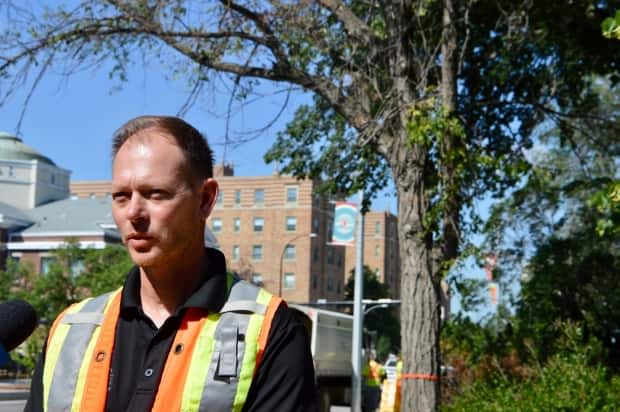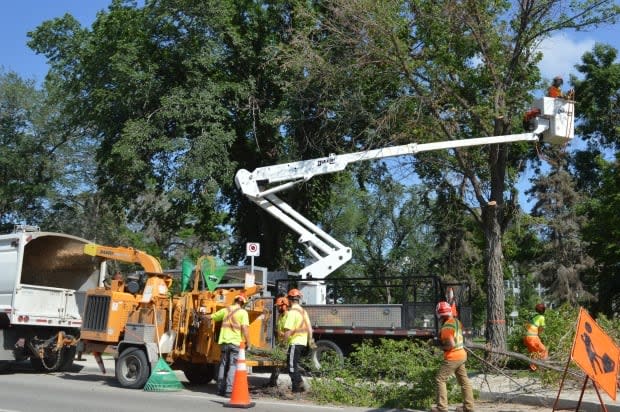Regina work crew culls tree infected with Dutch elm disease in Victoria Park

A City of Regina work crew made quick work of an elm tree in Victoria Park on Friday after it was confirmed to be infected with Dutch elm disease.
Using a bucket lift, a saw and a wood chipper, they reduced the tree — which helped mark the border of the park along Victoria Avenue — to wood chips.
With their work done, crews will take the chips to the city's landfill, where they'll be buried to help stop the spread of the incredibly damaging disease.
"We're very diligent. We have a very good program. So if we can find these trees we remove them quickly," said Ryan Johnston, the city's pest control supervisor.

Dutch elm disease is caused by a fungus carried by the elm bark beetle.
Once the fungus takes hold it affects the vascular system of the tree, preventing it from getting water and eventually causing it to wilt and die.
"What we look for is flagging dead branches. When I say flagging, I mean green leaves that will turn yellow and wilt, and eventually brown, and die," Johnston said.
Regina has approximately 55,000 city-owned elm trees. The city operates a monitoring and surveillance program that looks for signs of Dutch elm disease.
If a tree is suspected to have it, a sample is taken and submitted to laboratory tests.
When a test comes back positive, the city acts quickly and culls the elm and also injects nearby trees with a fungicide with the goal of stopping any spread.
"We will remove that as soon as we can," said Johnston.
So far this year, the city has confirmed six trees infected with Dutch elm disease. However, a few more trees are expected to test positive for the fungus.
About 10 to 15 trees are cut down as a result of the disease every year, Johnston said.
Along with the monitoring program, there is a prohibition of pruning elm trees between April 31 and Aug. 31.
Pruning produces a pheromone that attracts the elm bark beetle.Large quantities of the wood also produce the pheromone, which is why the city also prohibits the import of elm wood from outside Regina into the city.
"This tree next to us is about 100 years old. Over 100 years old. So this is one of the original trees to Victoria Park... We'd really hate to lose it," Johnston said, pointing to the tree next to the blighted greenery.

Linda Moskalyk, president of SOS Trees in Saskatoon, said the six cases in Regina is disappointing and a "really sad situation."
"It is a big deal because it's something that's happening every year. And yeah, 50,000 trees is a lot of trees, but they could get in a situation like Winnipeg where they just they lose thousands of trees every year. So I hope it doesn't get to that," Moskalyk said.
SOS Trees started in 1992 because of a Dutch elm disease scare, she said.
"We lobbied the government [and] the City of Saskatoon to get more funding for maintenance of trees and better pruning and surveillance. And since then, we have also concentrated on all kinds of different tree issues and education."
Now, Moskalyk said the organization has returned to focusing on the risk of Dutch elm disease.
Anyone who spots a tree with symptoms that look like Dutch elm disease is asked to call 306-777-7000 and alert Service Regina.


